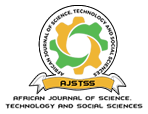Adsorption of Pb(II), Hg(II) and Cu(II) ions on azacrown ether grafted chitosan films
DOI:
https://doi.org/10.58506/ajstss.v1i2.7Keywords:
Chitosan, crown ether, crosslinked chitosan, metal ion adsorption, water pollutionAbstract
The adsorption and desorption of Cu(II), Pb(II) and Hg(II) ions from aqueous solutions by porous azacrown ether grafted chitosan films (Ch-DAC) were studied in a batch adsorption system. The porous Ch-DAC films were prepared by hydroamination reaction of azacrown ether activated double bonds with chitosan by changing the proportion of Ch/DAC with 1:0, 1:0.125, 1:0.167, 1:0.25 and 1:0.5 ratios. Characteristics of the films such as pH of aqueous slurry, pH of zero-point charge (pHzpc), surface area and pore volume, energy dispersive X-ray spectroscopy (EDX), Field Emission - Scanning Electron Microscopy (FE-SEM), Fourier transform infrared (FTIR) were investigated. Factors influencing adsorption performance such as pH of the solution, metal ion concentration, adsorbent dosage and the DAC content were studied. Batch studies, investigating film adsorption capacity and adsorption isotherms for Pb(II), Hg(II) and Cu(II) ion adsorption equilibrium correlated well with Langmuir model. The maximum capacity for the adsorption of Pb(II), Hg(II) and Cu(II) ions calculated from the Langmuir isotherm was 256, 200 and 143 mg/g respectively. Compared with the pure non-grafted chitosan films, the azacrown ether films were proved to have better sorption performance for the Pb(II), Hg(II) and Cu(II) ions at pH 5 to 6.


